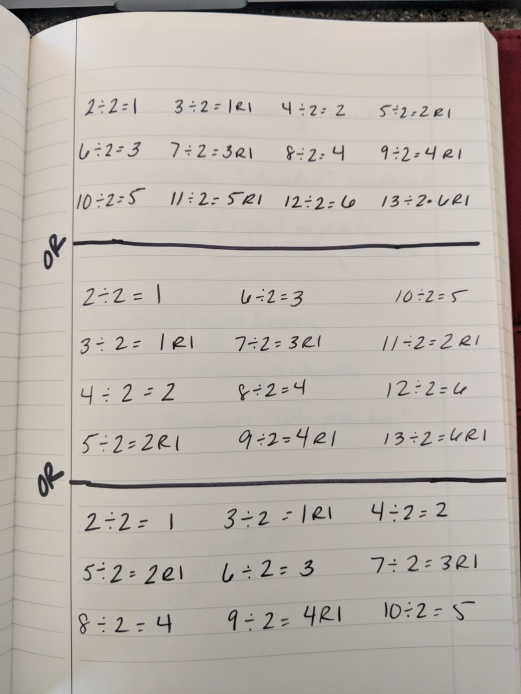I love when I read a blog post in which I can relate to how the teacher felt, learn from both the teacher and student thinking, want to hear what happens next, and leave with questions circling around in my head. This happened when I read Marilyn’s recent post. I really appreciated how her recount of the lesson demonstrated the importance of number choice and the honest way we all have felt when we made a decision during a lesson that we wished we hadn’t. It was really interesting to think about how changing the divisor from 4 to 5 changed what students experienced. I cannot wait to hear what they do when they try the original problem and see the remainder as 1 in the balloon context, 25¢ in the money context, 1/4 in the cookie context and .25 on the calculator. Awesome discussions could happen there!
I left this post still thinking about the math talk at the launch of the lesson. I was going to tweet about it, but because it seemed long and I have many questions of my own I want to play around with and revisit, I decided to put it here. I loved the connectedness of the number talk to the division task, and wondered how the recording of those strings could impact division patterns and structure students may see in future lessons. I started playing around with it in my journal in terms of how we think about recording a choral count.
I thought about:
- How many problems in each row?
- Does horizontal vs vertical recording impact what we see?
- What might students notice about the remainders in each row? column?
- What might students notice about the change in dividends in each row? column?

Not that I would launch the 4 Problems task with this following string, but I wondered what it would look like to change the divisor and what students might see here:

I think the number of problems with remainders at the bottom of the list versus the top is really interesting.
THEN, I started wondering about ways we could record the remainder and how that may impact how students interpret it? Not sure how this would work in terms of launch and facilitation, but I like thinking about the pink writing here.


Recording is one of those things I get so intrigued by and cannot wait to revisit this post, play around with patterns that could be elicited in different ways and think about tasks in which these talks could be connected.
Thank you, as always, Marilyn for sharing your work – you continue to be such an inspiration! My only hope is one day I can be in the room for one of your lessons!
This post made me see division in a new light. I have always thought about division as how many groups of one number could be found inside another number, with how many remaining, so seeing your first list of problems didn’t stand out to me. But then when I saw your string of problems with 24 divided by 1, 2, 3… A lightbulb went off in my head! I thought “Oh my gosh, that such a beautiful way for the kids to see it! The original number can be thought of as the divisor times the quotient plus the remainder!” Then when I saw your next lists, with the pink writing, I thought “That’s exactly what I was thinking!” This just made so much sense to me. And thank you for referencing Marilyn’s blog post, I went and read it also!
LikeLike
I have done these sorts of strings before in the classroom — in fact, they are explicitly in Marilyn’s “Do the Math” curriculum — but I had never thought about recording them any way but in a vertical list! I love these. There’s so much power in using different numbers of columns, too. What would happen if we used two columns instead of the 4 you tried? Would students get too stuck on odd/even? Or are they already too “used to” that pattern, and thus using 4 columns will force them to think more about the connections between these numbers? Or what if we did dividing by 2 with 2 columns, a divisor of 3 with 3 columns…etc. what would that reveal about the patterns? What interesting mathematics might that obscure?
While I always loved seeing the student work in your posts, it’s nice to get to see inside your journal, too. 🙂
LikeLike
Thanks, Kristin, for your blog. It’s timely because Sara and I are meeting this afternoon to plan next steps. (Her students don’t return to school until January 8.) About the recording you did in pink, that format was introduced to the class and some students use it regularly. I look forward to hearing what you do with the ideas. And if you get near the Bay Area, come visit the class with me!
LikeLike
Pingback: Remainders remain a puzzle - Making Your Own Sense